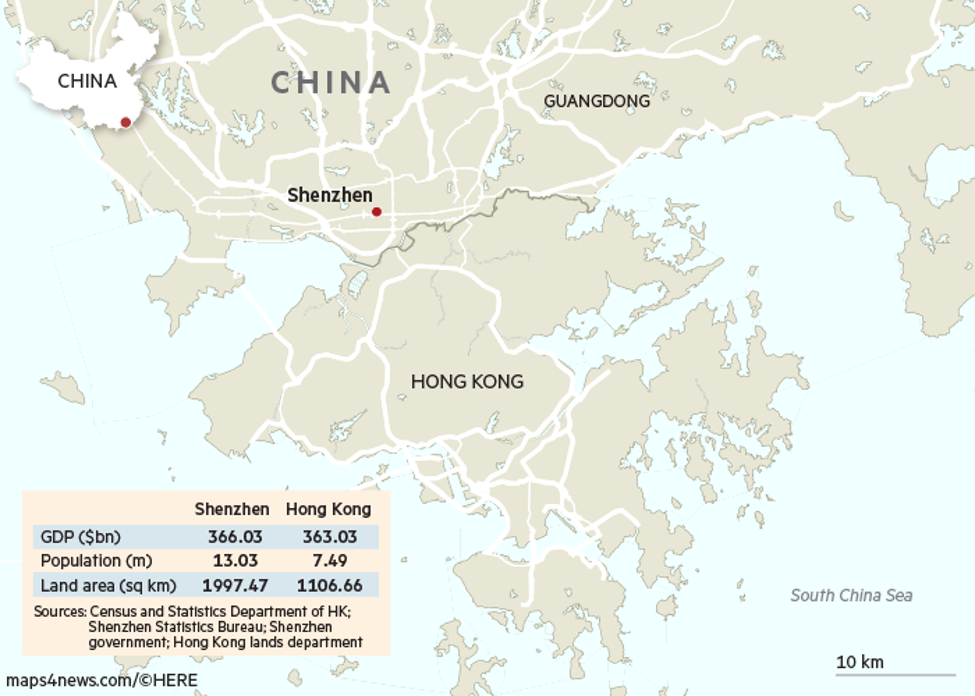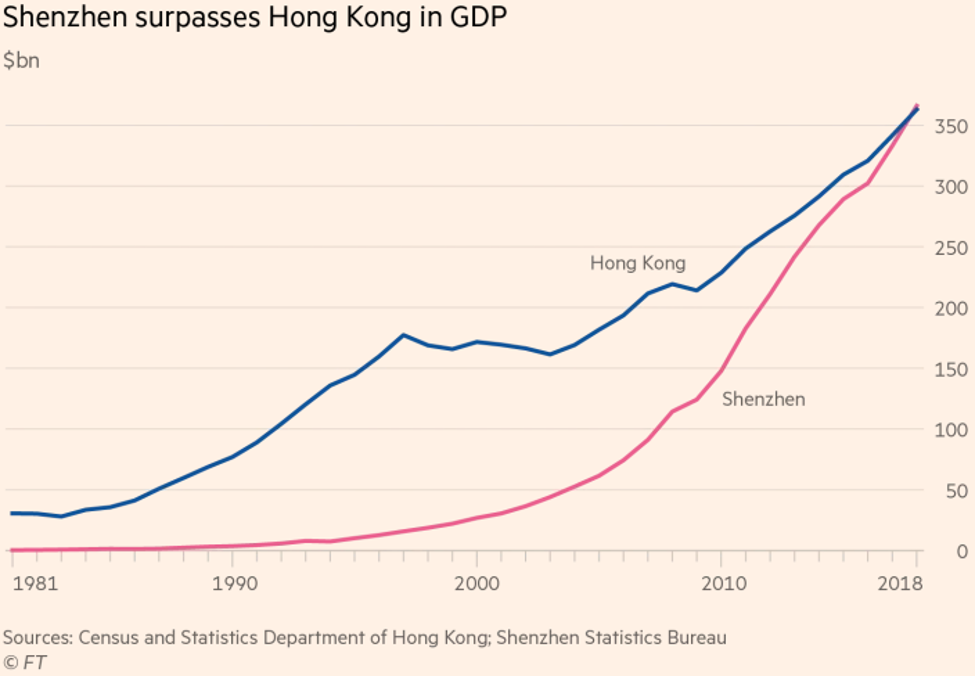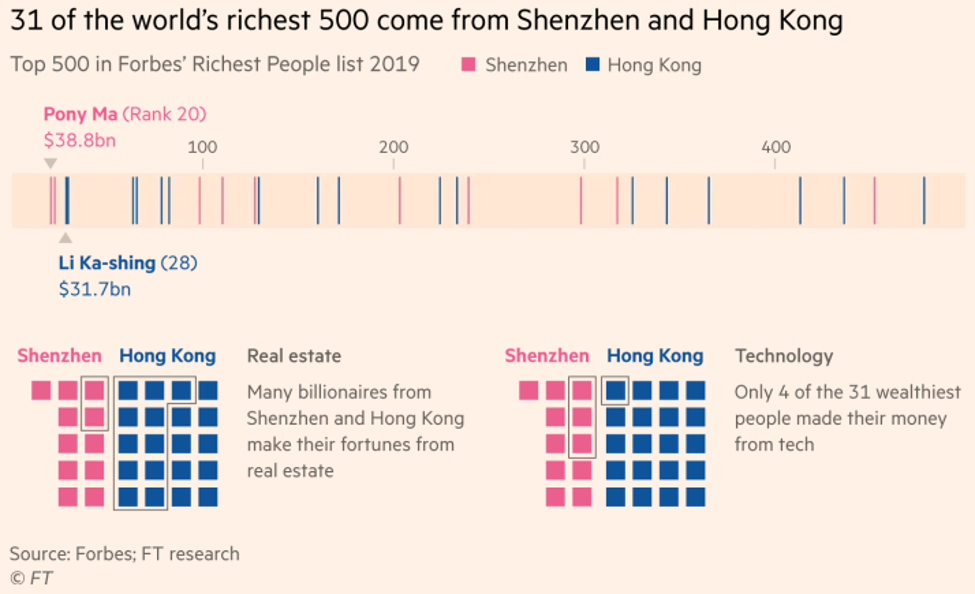
Source: The Financial Times
Just 15 minutes away from Hong Kong by train is the mainland Chinese city of Shenzhen. A rural backwater 40 years ago, it has expanded rapidly in recent decades and is now the home of Chinese technology champions Huawei, Tencent and DJI. As Hong Kong’s worst political crisis in decades rattles on into its ninth month, some are asking: can Shenzhen take its place?
Beijing in August unveiled a set of wide-ranging reforms intended to boost Shenzhen’s economy and elevate its position in China. Some analysts see the move as a threat to the status of protest-rattled Hong Kong.
“The policy was announced to intimidate Hong Kong. It was propaganda meant to scare Hong Kong people,” said Willy Lam, a professor of Chinese politics at the Chinese University of Hong Kong.
“
There have been other central government policies aimed at bolstering the role of the Pearl River Delta in southern China. President Xi Jinping’s Greater Bay Area intends to merge 11 cities, including Hong Kong and Shenzhen, into a single hub that could rival the San Francisco Bay Area, New York and Tokyo.
But Hong Kong still has several big advantages over Shenzhen: free access to the internet, freedom of speech, the rule of law and free flow of capital. Three-quarters of all funding from Chinese offshore initial public offerings was raised in Hong Kong, according to Dealogic. It is also the world’s largest offshore renminbi business hub, according to the Hong Kong Monetary Authority.
The Financial Times compares the two cities.

Source: The Financial Times
Shenzhen’s GDP has surpassed Hong Kong’s Shenzhen’s gross domestic product in 2018 overtook Hong Kong’s for the first time, partly because of its booming high-tech industry. Ever since Deng Xiaoping, China’s reforming leader, designated Shenzhen as the country’s first special economic zone in 1980, the economies of the two cities have been intertwined. Shenzhen’s rapid economic development has also been spurred by its proximity to Hong Kong’s access to foreign capital, technology and talent.
In the third quarter of 2019, Hong Kong fell into recession for the first time in a decade and economists expect the contraction to deepen. Hong Kong’s woes, coupled with the US-China trade war, have also hit Shenzhen’s growth and delayed progress on the Greater Bay Area plan.
Shenzhen achieved its highest ranking as a global financial center in 2019, according to an index by consultancy Z/Yen. But it still lagged behind Hong Kong, which ranked third globally. Hong Kong remains far ahead of Shenzhen in terms of ease of doing business. It also benefits from its unique status as a link between China and the world.
Beijing is eager to improve the ease of doing business in Shenzhen and increase its role as a financial hub. That may eventually weaken Hong Kong’s position as an offshore renminbi center, according to a report from Ping An Securities Research Institute.
Property is the main source of wealth
According to Forbes, 31 of the world’s 500 wealthiest people come from Hong Kong or Shenzhen. Of those, more than half from Hong Kong made their money in property, compared with just two from Shenzhen.
Property prices in both cities are among the highest in the world. Hong Kong was ranked the world’s most expensive housing market last year with an average property costing $1,235,220. Shenzhen was ranked fifth, and its average apartment price was $680,283, according to CBRE, the world’s largest property services company by revenue.
Only a handful of Shenzhen’s wealthiest residents made their fortune from the tech industry. They include Pony Ma, founder of Tencent.

Source: The Financial Times
Shenzhen’s universities lag behind Hong Kong’s
Hong Kong’s universities far outrank those of Shenzhen. Six universities in Hong Kong made the top
500 of the 2020 Times Higher Education World University Rankings, compared with one from Shenzhen.
Shenzhen is aware of its lack of prestigious academic institutions and the city has focused efforts on building colleges and universities, as well as strengthening ties with educational institutions overseas. Partnerships include links with the University of Cambridge and the University of California, Berkeley.
Hong Kong’s airport is busier
When protesters in Hong Kong temporarily shut down the city’s airport in August 2019, businesses were worried that the action would threaten the territory’s status as an international transport hub, with passengers considering alternatives.
The number of passengers traveling through Shenzhen’s airport grew by more than 10 per cent in the third quarter of 2019 as they rerouted travel amid the chaos in Hong Kong, according to figures from the airport’s operator.
From Shenzhen, airlines fly to 173 destinations, mostly in China, with the airport processing more than 49m passengers in 2018, according to Shenzhen Airport Group. Nearly 75m travelers passed through Hong Kong International Airport in the same year, flying to more than 220 destinations worldwide.
Source: The Financial Times, January 21, 2020| Qianer Liu, Sue-Ling Wong, & Jane Pong